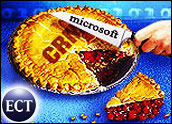
Intervoice has just introduced new self-service voice products based on SCXML (State Chart XML) — a dialogue language that can be used in multiple contexts and, most intriguingly for vendors and end users, multiple modes.
In Intervoice’s case, it has incorporated a runtime-service-orchestration engine based on SCXML in its latest iteration of its Intervoice Voice Portal and a new contact center application for the financial services industry.
This architecture enables simultaneous communications, allowing, for instance, a contact center rep to do a voice scan on a customer for security reasons while helping him on the phone. Another use case would be a travel Web site that lets customers book seats on a flight by phone but then switch to a PDA to visually select the seat assignment.
In theory, such use cases are possible already, Ken Goldberg, senior vice president, Corporate Development and Strategy for Intervoice, told CRM Buyer. “However, there were always latency issues. SCXML means these functions can be done simultaneously. It makes for an easier user experience.”
Newest of the New
Intervoice is definitely among the earliest adopters of SCXML, Ken Landoline, program manager at the Yankee Group, told CRM Buyer. He expects to see other vendors follow suit once the potential use cases become clear.
“You can, for instance, get help from a service rep while filling out an application form on a 3G phone. This makes all sorts of services much easier for people in the field,” he said.
It also provides product designers far more options. “SCXML means you can jump from mode to mode with no difficulty,” Landoline said.
It’s fitting that Intervoice is among the first companies to roll out such products, he added.
“It has traditionally been an IVR company. I think it now realizes though that it has to shift direction to stay with the market. The future is not in voice but in multimodal applications. It is among the handful of companies that do realize that.”
Enhancing Features
Much of the new version of Voice Portal is the enhancement of existing features, such as the reporting and management and development tools. Intervoice has also added new functionality such as media content services for recording, playback and better management of voice prompts.
Finally, the company added Enterprise Pro to its line up of packages, which includes Express and Enterprise.
Enterprise Pro features the Service Orchestration functionality, or what the company calls “State Control,” Goldberg explained. The Voice Portal is built on Intervoice’s Media Exchange platform. This platform has the new State Control component, which was built using SCXML, he stated.
Adaptive Authentication
Another product in which Intervoice has incorporated SCXML is a product it has launched with RSA, the security division of EMC. The two companies have signed an agreement to integrate Intervoice Voice Portal with RSA Adaptive Authentication for Phone.
The resulting application provides behind-the-scenes authentication. The majority of customers’ transactions would continue uninterrupted. Only those transactions flagged as high risk by the RSA Risk Engine would be required to show secondary authentication such as a biometric voiceprint sample or additional content match questions.
Such applications have become more in demand in response to new government regulations, such as the Federal Financial Institutions Examination Council’s (FFIEC) guidelines for multifactor authentication.
“As financial institutions enhance their Internet banking security, threats will migrate to additional remote channels, mainly phone banking,” Christopher Young, vice president, Consumer Solutions Group and Access Solutions Group at RSA, stated.
“The FFIEC guidance has always included the phone channel, although that wasn’t the focus of activity in 2006. Today, with the potential for threat migration and FFIEC attention, we’re seeing a shift in the market towards stronger security for telephone banking,” he noted.
Future Products
While this particular product targets the banking industry, additional strategic partnerships could focus on healthcare and insurance, Goldberg said. New regulations such as HIPPA have increased the need for stronger caller authentication just as much as the new rules governing the financial services industry regulations have, he added.
Intervoice plans to develop other SCXML-based products. This year, the company will roll out a self-service product called HomeZone that is able to adapt to the behavior of the caller on the fly, according to Goldberg. “Voice Portal and Intervoice Voice Portal with RSA Adaptive Authentication for Phone are just the beginning,” he concluded.























































